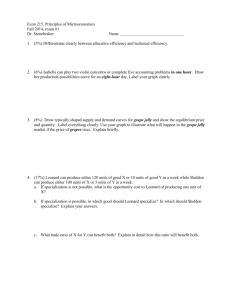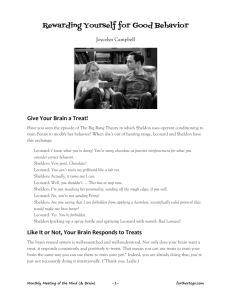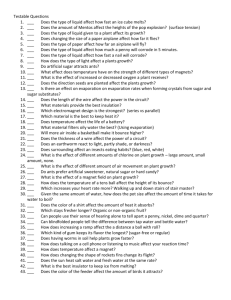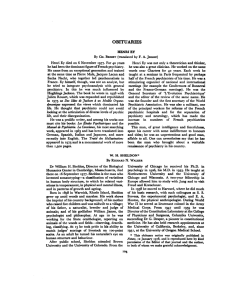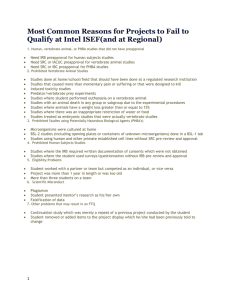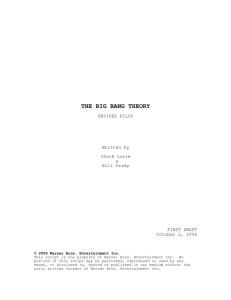The Good The Bad The Ugly
advertisement
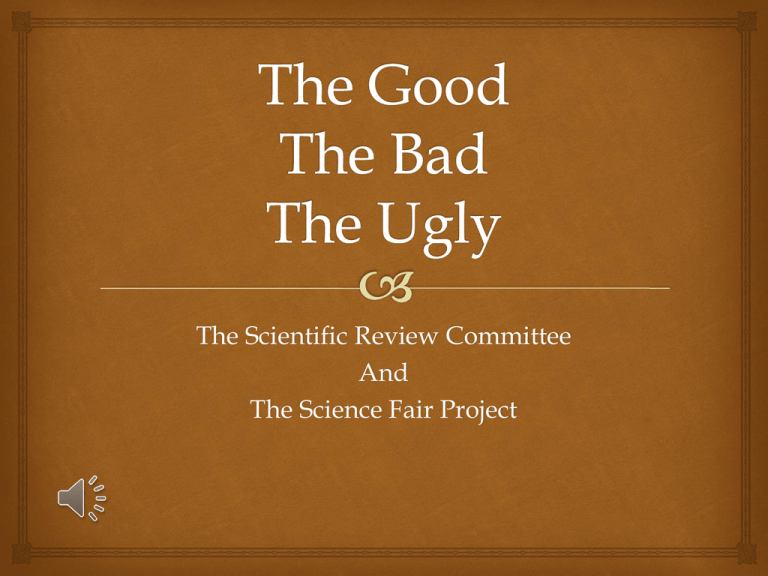
The Scientific Review Committee And The Science Fair Project What Types of Projects Are Verboten! Human, vertebrate animal, or PHBA studies that did not have preapproval Prohibited Vertebrate Animal Studies Studies done at home/school/field that should have been done at a regulated research institution Studies that caused more than momentary pain or suffering or that were designed to kill Induced toxicity studies Predator/vertebrate prey experiments Studies where student performed euthanasia on a vertebrate animal Studies with an animal death in any group or subgroup due to the experimental procedures What Types of Projects Are Verboten! Prohibited Studies using Potentially Hazardous Biological Agents (PHBA's) Microorganisms were cultured at home BSL-2 studies (including opening plates or containers of unknown microorganisms) done in a BSL-1 lab Studies using human and other primate established cell lines without SRC pre-review and approval Prohibited Human Participant Studies Studies where the IRB required written documentation of consents which were not obtained Studies where the student used surveys/questionnaires without IRB pre-review and approval What Forms Are, Or Maybe, Needed? 1B – Approval Form 1C - Regulated Research Institutional or Industrial Setting Form 2 - Qualified Scientist Form 3 - Risk Assessment Form 4 - Human Participants Form Human Informed Consent Form 5A -Vertebrate Animal Form 5B - Vertebrate Animal Form 6A - Potentially Hazardous Biological Agents Risk Assessment Form 6B - Human and Vertebrate Animal Tissue Form Case Study 1: Blood Sugar Levels Sheldon develops his science fair project around his interest in studying the effect of high sugar foods on blood sugar levels. His hypothesis: Consumption of sports drinks will result in a rapid increase of blood sugar levels because of the high sugar content in these products. Sheldon has obtained written consent from his grandmother and her physician to be the test subject in the experiment. He has attached this paperwork to his project documentation. Sheldon has completed the following forms: Form 2: Qualified Scientist (MeeMaw’s Dr.) Form 3: Risk Assessment Form 4: Consent He has also specified that the lancelets used to record the blood sugar levels will be disposed of by first placing them into a pressure cooker for an hour and them taken to MeeMaw’s doctor’s office for final disposal. Sheldon has specified in great detail the procedures he will use to perform his experiment • He will have MeeMaw take her blood sugar level at 0800, 1700, and 2200 • He will then have her drink 500 mL of Gatorade and then take her blood sugar levels at 5 minutes, 10 minutes, and 15 minutes after she drinks the liquid. The results will be recorded, tabulated, and presented to evaluate whether or not sports drinks immediately increase blood sugar levels. Good, Bad, or Ugly? Case Study 2: Temperature & Respiration Leonard, being asthmatic, is interested in examining whether or not temperature has an effect on respiration. He talks with his local veterinarian and enlists her help because he wants to use Carassius auratus auratus (common goldfish) in the study. All of the experimentation was conducted at the vet’s lab under her observation and supervision. Before starting the experiment, Leonard submitted forms 1B, 2B, 3, 5A, and 5B to his school’s science fair sponsor. Leonard conducted his experiment by measuring the water temperature and recording the number of times which the goldfish’s gill flap (operculum) moved. He decreased the water temperature by adding ice to the tank, while to increase the temperature he added hot water. The fish in the experiment did not die. Good, Bad, Ugly? Case Study 3: Voice tone and Canine Behavior Penny develops a project to study what effect the tone used when giving a command to a dog has on its behavior and response. She speaks with her local psychologist who agrees to serve as the Qualified Scientist. Penny completes and submits forms 1B, 2, 3, 5A, and 5B to her science fair sponsor before conducting the experiment. Her procedure is as follows: Penny conducted six (6) different trials The difference in each test will be measured again baseline which is normal voice and no body language. Subsequent tests will be changing the voice level across all commands or adding body language or both to see if the trained dog reacts different from the base. No dogs were harmed during the experiment. Good, Bad, or Ugly? The Reason the SRC Exists Sheldon: Do you want to hear an interesting thing about stairs? Leonard: Not really! Sheldon: If the height of a step is off by as little as two millimeters, most people will trip. Leonard: I don't care. 2 millime--? That doesn't seem right. Sheldon: It's true. I did a series of experiments when I was 12. My father broke his clavicle. Leonard: Is that why they sent you to boarding school? Sheldon: No. That was the result of my work with lasers.

